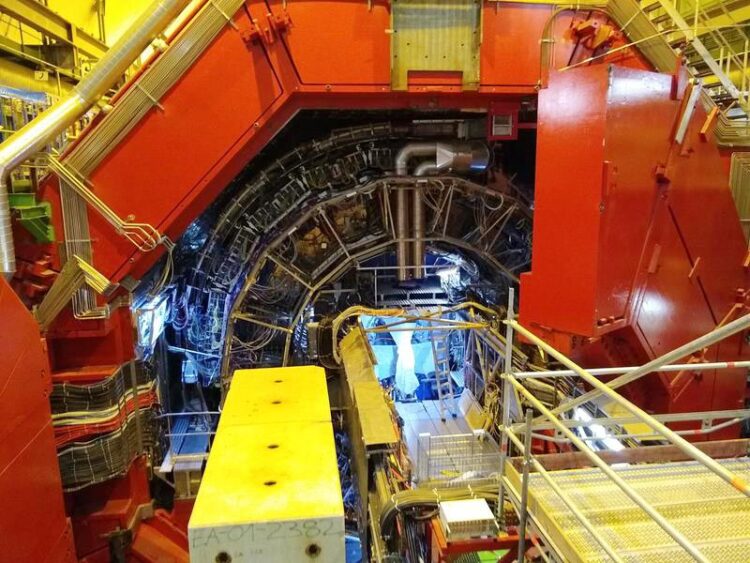Tiny Big Bang: ALICE experiment restarts with lead ions

To carry out the upgrade, the ALICE detector had to be opened.
(c) Sebastian Scheid / Goethe University Frankfurt
Goethe University Frankfurt helped set new measurement record.
After a five-year break, the large LHC accelerator at the CERN international research institute has once again brought lead ions to collision. During the process, the colliding matter dissolves into its components for an extremely short time, reaching a state like the one that prevailed in the universe a few millionths of a second after the Big Bang. The particle tracks of these collisions are recorded by the house-sized ALICE detector, which Goethe University researchers helped upgrade. Already during the first month of the new data collection period, a new record was set: 20 times more collision events were registered than in the data-taking periods of previous years combined.
On September 26, 2023, the accelerator team at the CERN European Council for Nuclear Research in Geneva declared stable lead-beam conditions, ushering in the first data-taking campaign of lead-ion collisions in five years. From then until the late evening of October 29, the accelerator produced lead-ion collisions at the world’s highest-ever collision energy of 5.36 terra electron volts per colliding nuclear particle (nucleon-nucleon collision). In addition to the collision energy, the collision rates also increased significantly compared to the data taking periods of previous years. The ALICE detector, specialized in recording lead atomic nucleus collisions, recorded 20 times more events than in the previous four data-taking periods combined – each of which lasted about one month, and the first of which dates back to 2010.
This is important because of the tremendous number of particles that are created and decay in a very short timeframe during the collisions. Recording the tracks of these particles allows conclusions to be drawn about exactly what happens at the moment of collision and shortly thereafter: The particles dissolve into their elementary components – quarks and gluons – and form a kind of “matter soup”, a so-called quark-gluon plasma. Immediately afterwards, new, very unstable particles form again, which finally transform into stable particles in complex decay chains. In this way, researchers in the ALICE experiment are studying the properties of matter as it existed shortly after the Big Bang.
Research groups from Goethe University Frankfurt are part of the experiments: The new record was first made possible because the world’s most powerful particle accelerator, the Large Hadron Collider (LHC), was upgraded during the four-year reconstruction phase from 2018 to 2022. The upgrades of the ALICE detector during the same timeframe enable it to record the traces of the LHC’s higher collision rates.
To carry out these upgrades, it was necessary to replace the readout detectors of the experiment’s central detector, the so-called Time Projection Chamber (TPC). Professor Harald Appelshäuser from Goethe University’s Institute for Nuclear Physics Frankfurt (IKF) serves as project lead for this 10-year undertaking.
The enormous amount of data generated during the measurements – which reaches the range of terabytes per second for the TPC alone – constitutes a major challenge. To be able to sufficiently reduce the amount of data stored, this data stream must be processed in real time, using effective pattern recognition methods. The Event Processing Nodes (EPN) computing cluster was set up specifically for this experiment. Based on both conventional computing cores (CPUs) and special graphics processors, the EPN project is led by Volker Lindenstruth, Professor for High-Performance Computer Architecture at Goethe University and Fellow at the Frankfurt Institute for Advanced Studies (FIAS).
The measurements at higher collision rates are a major success for CERN’s heavy ion program. Prof. Appelshäuser: “It’s finally happening! We have been working towards this for 10 years, and are looking forward to evaluating the data we have now obtained. I would especially like to thank Germany’s Federal Ministry of Education and Research for its long-term funding, not least since the only way for research projects of this dimension to be successful is by having such a reliable partner on board.”
Wissenschaftliche Ansprechpartner:
Professor Harald Appelshäuser
Institute for Nuclear Physics
Goethe University Frankfurt
Tel: +49 (0) 69 798-47034 or 47023
appels@ikf.uni-frankfurt.de
@ALICExperiment @goetheuni
Weitere Informationen:
https://aktuelles.uni-frankfurt.de/english/big-bang-research-alice-experiment-at… News release: ALICE experiment at CERN starts test operation with lead ions (2022)
https://home.cern/science/experiments/alice About the ALICE experiment
Media Contact
All latest news from the category: Information Technology
Here you can find a summary of innovations in the fields of information and data processing and up-to-date developments on IT equipment and hardware.
This area covers topics such as IT services, IT architectures, IT management and telecommunications.
Newest articles

NASA: Mystery of life’s handedness deepens
The mystery of why life uses molecules with specific orientations has deepened with a NASA-funded discovery that RNA — a key molecule thought to have potentially held the instructions for…

What are the effects of historic lithium mining on water quality?
Study reveals low levels of common contaminants but high levels of other elements in waters associated with an abandoned lithium mine. Lithium ore and mining waste from a historic lithium…

Quantum-inspired design boosts efficiency of heat-to-electricity conversion
Rice engineers take unconventional route to improving thermophotovoltaic systems. Researchers at Rice University have found a new way to improve a key element of thermophotovoltaic (TPV) systems, which convert heat…



